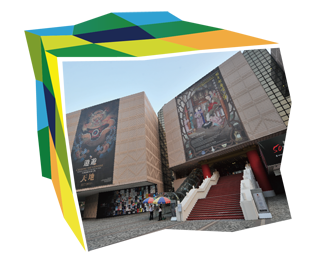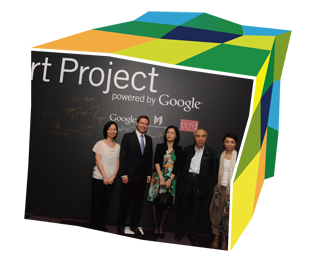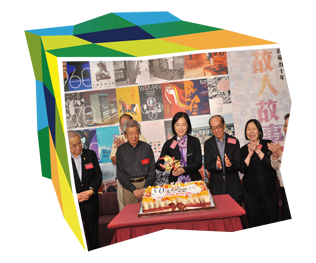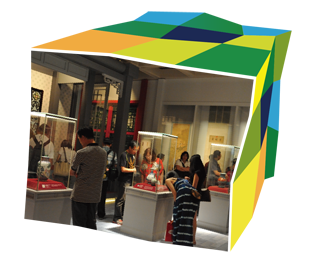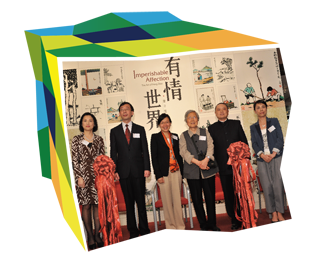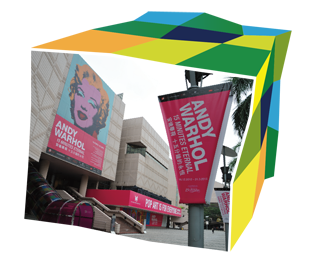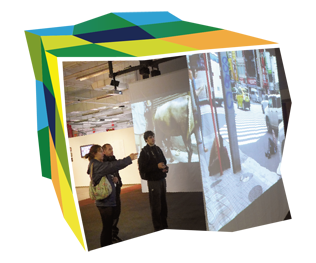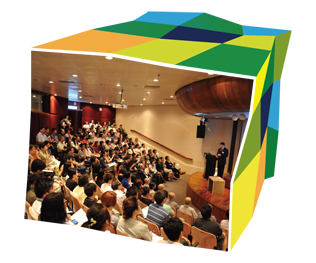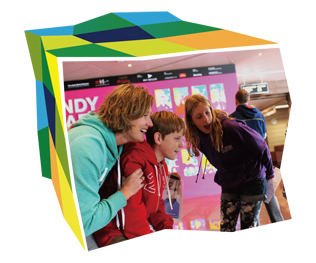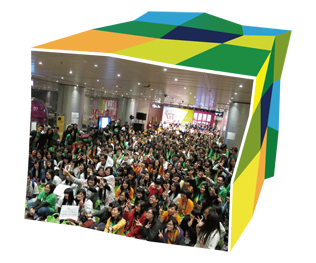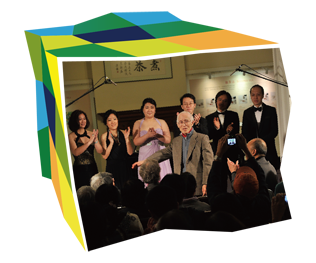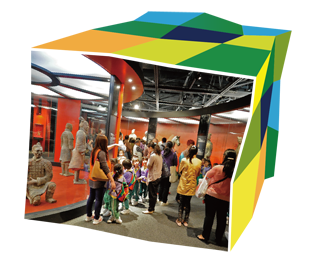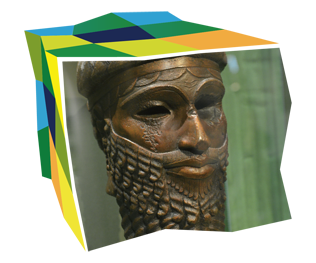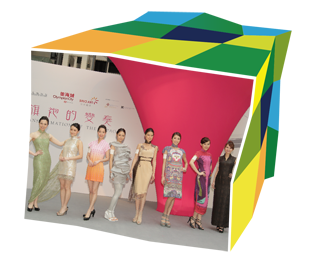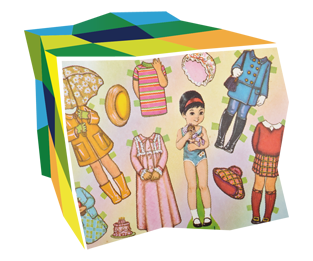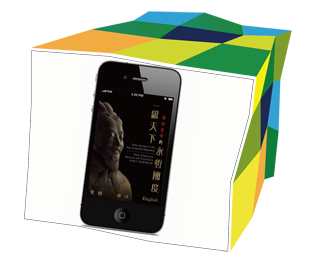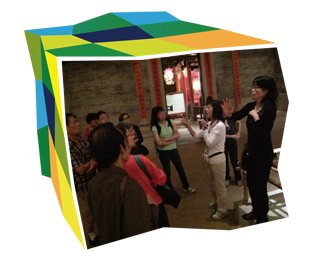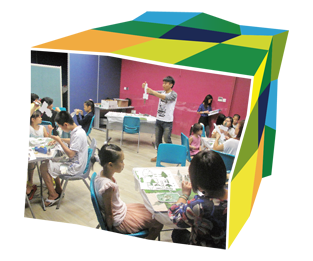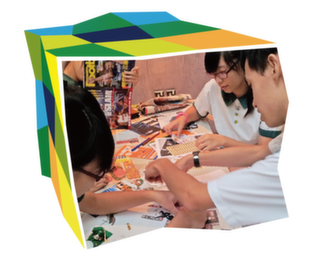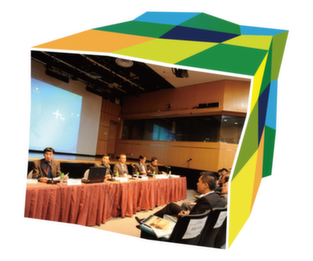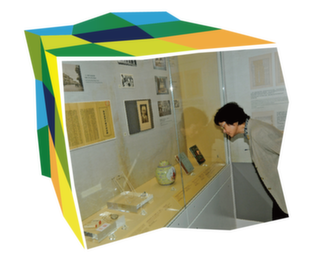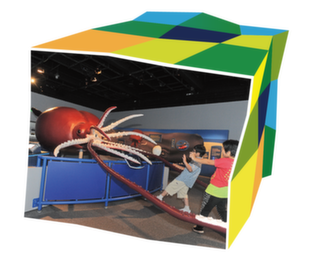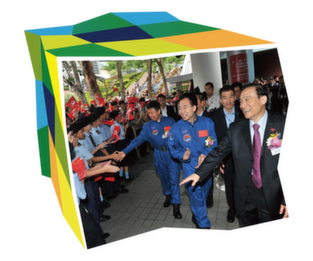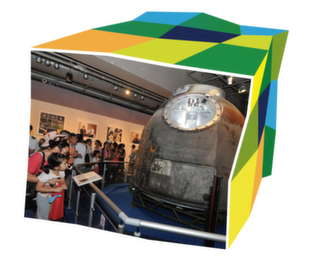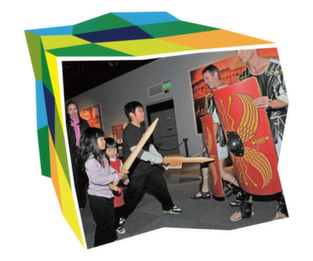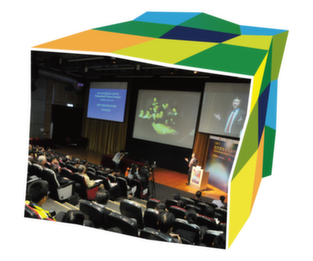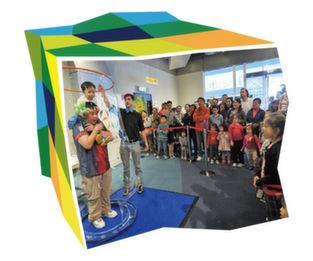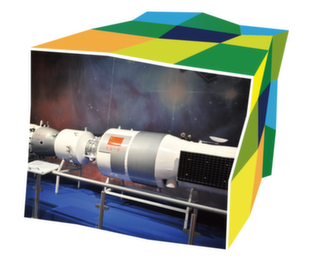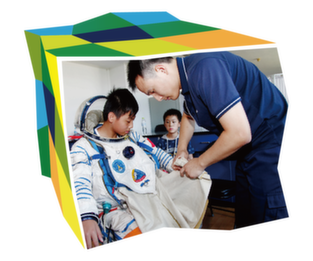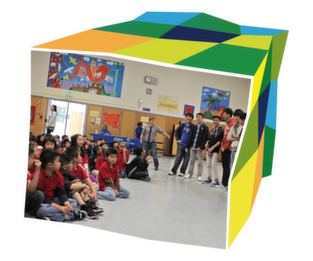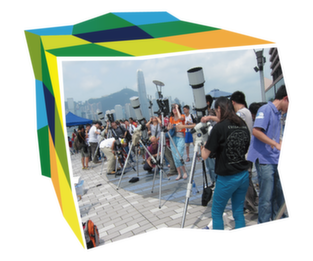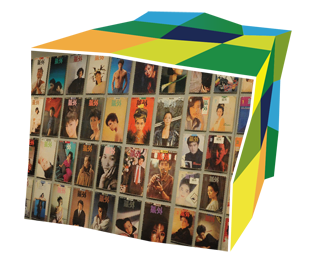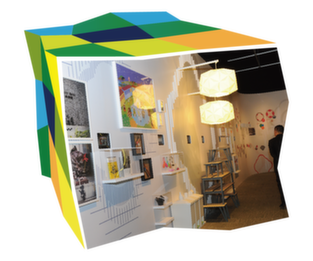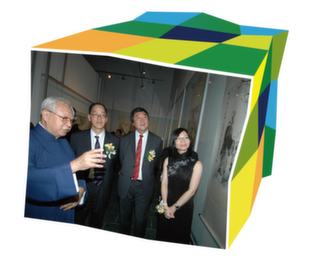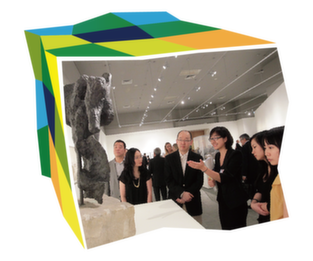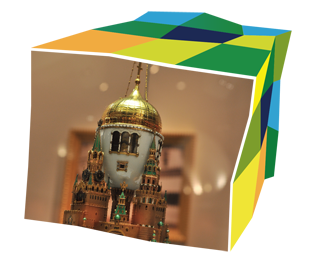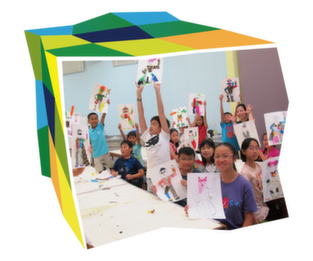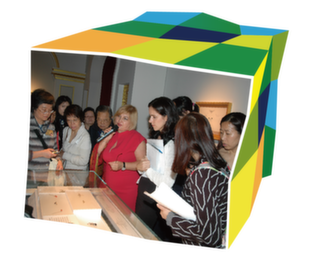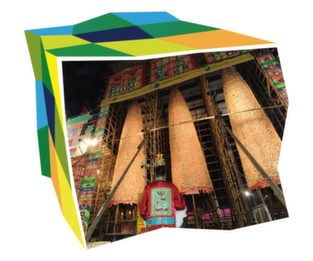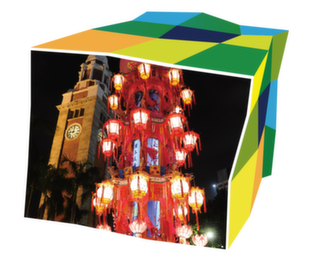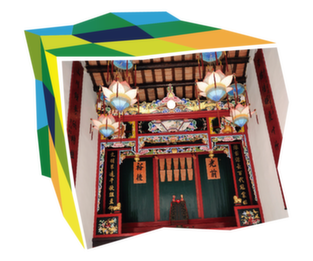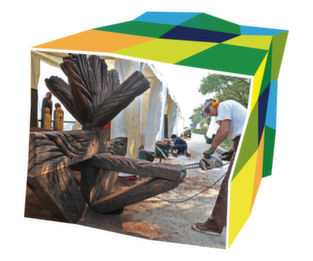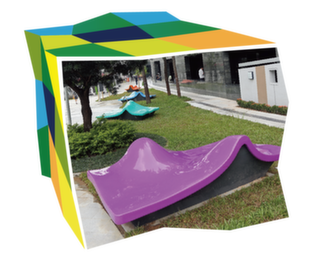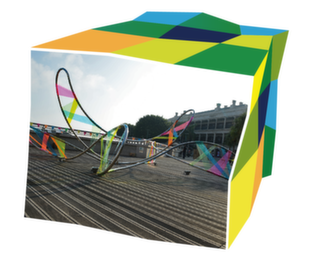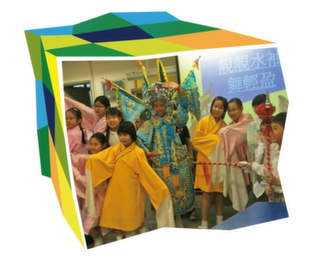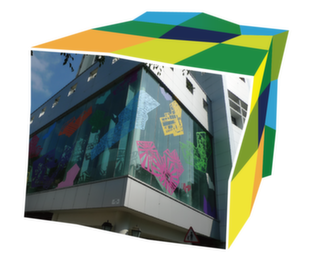Museums
The LCSD manages seven major museums: the Hong Kong Museum of Art, the Hong Kong Museum of History, the Hong Kong Museum of Coastal Defence, the Hong Kong Science Museum, the Hong Kong Space Museum, the Hong Kong Heritage Museum, and the Dr Sun Yat-sen Museum. Their roles are to acquire, conserve, research, exhibit and interpret both Hong Kong’s tangible and its ICH.
The department also manages the Hong Kong Film Archive, the Art Promotion Office, the Hong Kong Heritage Discovery Centre, and the Ping Shan Tang Clan Gallery cum Heritage Trail Visitors Centre, along with seven smaller museums, namely the Flagstaff House Museum of Tea Ware, the Lei Cheng Uk Han Tomb Museum, the Law Uk Folk Museum, the Sheung Yiu Folk Museum, the Sam Tung Uk Museum, the Hong Kong Railway Museum, and the Fireboat Alexander Grantham Exhibition Gallery.
In 2012-13, over 6.2 million visitors patronised the LCSD’s museums. We will continue to roll out inspiring and enjoyable exhibitions and programmes for a range of different audiences. To boost publicity of programmes at museums and increase our audience base, the department has set up a new Marketing and Business Development Section. It is working to strengthen branding and promotion work, and cultivate partnerships with external entities. The Hong Kong Public Museums portal was launched in February 2012 as a one-stop-shop for programmes and activities offered by the 14 museums, two heritage centres, one film archive and one visual arts centre under the LCSD’s management.
The Hong Kong Museum of Art and the Hong Kong Heritage Museum joined the Google Art Project in April 2012 to showcase 187 artworks, most of which are by renowned Hong Kong artists. This project allows Hong Kong art to be shared in fine detail with a global audience, anywhere and anytime.
In 2012, the LCSD published its first Five-Year Corporate Business Plan for the public museums, covering 2012-17. The Corporate Business Plan lays out the vision, mission, core values, and plans for achieving excellence for museums. Individual museums and offices also drew up their own Annual Plans for 2012-13.
Museum Advisory Panels
Three Museum Advisory Panels (Art, History and Science) were set up in October 2010 to enhance accountability and public involvement in the management of the museums. In the year under review, they continued to advise the department on the positioning of museums, on strategies for business development, marketing and community involvement, and on measures for enhancing operational efficiency and accountability. The panels comprise academics, museum experts, artists, art promoters, marketing / public relations experts, and community leaders.
Intangible Cultural Heritage Advisory Committee
The Intangible Cultural Heritage Advisory Committee was set up in July 2008 to monitor and advise on the first territory-wide survey of Hong Kong’s ICH. The committee, which comprises local academics, experts and prominent community figures, commenced its third term on January 1, 2013, with an expanded membership incorporating a wider range of experts. Its terms of reference were also widened to cover the safeguarding of our ICH, including such remit of research, promotion, enhancement, transmission and revitalisation.
Museum Trainee Programme
A Museum Trainee Programme was begun in 2010 to develop museum professionals. Trainees were attached to the Hong Kong Museum of Art, the Hong Kong Museum of History, the Hong Kong Heritage Museum, the Hong Kong Film Archive, the Art Promotion Office and the Conservation Office, and received two-year on-the-job training in museum management or conservation services.
Under their supervisors, trainees learnt how to manage museum services and organise education programmes. They also got hands-on experience in curating exhibitions and projects. The number of trainees has been increased to 15 for phase 2 (2012-14). In anticipation of an increasing demand for professional museum curators to manage cultural facilities and organise cultural activities, the department intends to offer even more places in the future.
Hong Kong Museum of Art
The Hong Kong Museum of Art marked its golden jubilee in 2012; an array of exciting programmes was organised to celebrate this memorable occasion. It staged a special exhibition “Collecting for 50 Years – The People and Their Stories” to acknowledge the many behind-the-scene players who have been crucial in shaping the museum over the decades. A dynamic mix of blockbuster exhibitions ranging from classical antiquities through ancient and contemporary Chinese paintings to western pop art was also presented, attracting over 763 210 visitors.
During the year, the Hong Kong Museum of Art and the Palace Museum co-organised the exhibition A Lofty Retreat from the Red Dust: The Secret Garden of Emperor Qianlong to celebrate both the 15th anniversary of the establishment of the HKSAR and the 50th anniversary of the museum. Audiences could appreciate the beauty and cultural significance of the artefacts and architecture of the Qianlong Garden, a secret complex in the Forbidden City once unknown to the outside world.
With Imperishable Affection: The Art of Feng Zikai the museum pulled off something of a coup by assembling a comprehensive selection of works by Feng Zikai, an artist recognised in his lifetime as the ‘father of Chinese cartoons’.
Chinese Painting and Calligraphy of the Song, Yuan and Ming Dynasties from the Osaka City Museum of Fine Arts showcased an impressive collection of ancient Chinese painting and calligraphy from the Osaka City Museum of Fine Arts, renowned for its collection of ancient Japanese and Chinese objects. Andy Warhol: 15 Minutes Eternal was an all-encompassing exhibition that featured over 460 paintings, drawings, photographs, and film and screen prints by this iconic artist of America’s Pop Art Movement. The exhibition offered a complete Warhol retrospective, and was the largest collection of the artist’s work ever to come to Hong Kong. To strengthen cultural collaboration within the Pearl River Delta Region, the Hong Kong Museum of Art, the Guangdong Museum and the Macao Museum jointly organised a travelling exhibition Maritime Porcelain Road: Relics from Guangdong, Hong Kong and Macao Museums, to run from 2012 to 2014.
As a way of promoting local art talent, in February 2012 the Hong Kong Contemporary Art Awards 2012 was launched. It attracted 1 963 entries, from which a total of 97 artworks were selected for exhibition in 2013, including the 14 award winners. Delivering an in-depth study of the history of Hong Kong art, a collaborative project between the Hong Kong Museum of Art and the Asia Art Archive, Hong Kong Art History Research – Pilot Project commenced in March 2013. In addition, the All Are Guests exhibition was shown at the 7th Liverpool Biennial in the UK from September to November 2012, in a move designed to foster cultural exchange and promote Hong Kong artists overseas.
The museum also offered a wide array of educational programmes to enhance public appreciation of art. To tie in with A Lofty Retreat from the Red Dust: the Secret Garden of Emperor Qianlong, a large interactive area with elements of illustration, QR Code information and 3D modelling was built inside the gallery. These, together with a series of in-house and outreach activities, added a diverse range of Chinese cultural and historical associations to the exhibition for visitors to explore.
The Andy Warhol: 15 Minutes Eternal – Art Appreciation Programme, sponsored by the Hong Kong Jockey Club Charities Trust, included lectures, an interactive game, free public guided tours and art accessibility activities for disabled groups, and was specially designed to enhance visitors’ interest in the exhibition. Another highlight event was A Night at the Museum of Art with Andy Warhol, co-organised with the University of Hong Kong. This was an innovative programme in which over 530 senior secondary school students were invited to take part in an exhilarating overnight journey, and explore new meanings associated with creativity and pop art, media and technology, culture and society, all inspired by Andy Warhol. In total, the museum’s education and extension programmes attracted over 103 138 participants during 2012/13.
The Museum of Art aims to provide a user-friendly website, and to this end it revamped its official website during the year, which was launched in February 2013.
Flagstaff House Museum of Tea Ware
The Flagstaff House Museum of Tea Ware is a branch of the Hong Kong Museum of Art. Its collection features tea ware and related implements from the collection of the late Dr K S Lo, as well as rare Chinese ceramics and seals donated by the K S Lo Foundation. The exhibition From Clay to Teapot: Tea Ware by Hong Kong Potters 1986-2010 showcased a collection of works by local potters made over the past two decades. Over 120 800 people visited the exhibition. Another exhibition, A Date with Chinese Tea, featured different types of tea in association with historical artefacts and background materials related to the practice of tea-drinking. From August 29, 2012 to March 31, 2013, over 74 274 people visited the exhibition. The museum, which also organised many activities to introduce people to tea ware and the art of tea drinking, attracted 203 073 visitors during the year.
Hong Kong Museum of History
The mission of the Hong Kong Museum of History is to foster interest in history, enrich cultural life, strengthen social cohesion, and nurture a national identity. It collects, preserves and displays cultural objects closely related to the history of Hong Kong, South China and beyond.
In addition to its permanent exhibition The Hong Kong Story, the museum presents various thematic exhibitions either on its own or in conjunction with other museums and cultural organisations from Hong Kong, the Mainland, and overseas.
A highlight programme to mark the 15th anniversary of the establishment of the Hong Kong Special Administrative Region was The Majesty of All Under Heaven: The Eternal Realm of China's First Emperor. This was the largest exhibition of Qin terracotta figures ever held in Hong Kong, and it broke the attendance record for all previous thematic exhibitions held by the museum, attracting 425 159 visitors. Featuring 20 different types of terracotta figures and other priceless relics from the Qin dynasty, together with a series of six innovative multimedia programmes, this exhibition gave visitors a unique glimpse of the splendours of Qin culture.
With more than 170 artefacts sourced from the magnificent collection of the British Museum, The Wonders of Ancient Mesopotamia exhibition explored significant episodes of ancient Mesopotamian history from 3500 to 539 BC, such as the birth of cities in Sumer, the rise of the powerful military empire of Assyria, and the development and legacy of cosmopolitan Babylon. The Hong Kong Currency exhibition showcased around 700 artefacts, including Hong Kong coins and notes of different periods and related items such as trial coins, minting tools, circulated coins, plaster models of commemorative coins, drawings of banknote designs, trial notes, plates for printing banknotes, uncut sheets of banknotes, and more. In addition, the museum joined hands with Hongkong Post to stage the exhibition History in Miniature: The 150th Anniversary of Stamp Issuance in Hong Kong. This presented visitors with another fascinating chapter of local history, told through some 300 examples of Hong Kong stamps.
The museum also collaborated with Sino Art and Olympian City to stage the Transformation of the Qipao exhibition at Olympian City from April to June 2012. This was the first attempt by the museum to bring its collections to a venue outside the museum, in a way that could reach out to the community and get closer to the everyday life of Hong Kong citizens.
To further build up its collections, during the year the museum launched a collection campaign with the aim of obtaining items related to children’s life in Hong Kong. More than 2 700 items were acquired through this campaign.
To promote the exhibition China’s First Emperor, online tools and resources such as Facebook, Twitter, a website, mobile applications and QR code were employed to keep the public updated on activities and ticketing arrangements. A book display was also co-organised with the Hong Kong Central Library in October 2012 to stimulate interest in this major exhibition.
In conjunction with the China’s First Emperor exhibition, and to help students learn more about Qin history and culture, three school competitions were organised on history, art and the terracotta warriors, as along with four public art programmes. In October 2012, an international conference connected with the exhibition was attended by some twenty experts and scholars from Hong Kong, the Mainland, Japan and the UK.
To foster public interest in local history and our cultural heritage, throughout the year the museum also organised a rich array of educational and extension activities, including special lectures, workshops for different target groups, field trips, film shows, competitions and outreach programmes.
In July 2012, the 2nd Inter-school Competition of Project Learning on Hong Kong’s History and Culture was held, and this was followed in January 2013 with the 6th Research on Historical Photos Writing Competition. The museum continued to organise lecture series with local universities, including the Hong Kong University of Science and Technology and the Centre for Hong Kong History and Culture Studies, Chu Hai College.
In addition, the museum collaborated with the Arts with the Disabled Association Hong Kong to run the Interactivity Scheme, which offers sign interpretation guided tours and model-making workshops for people with hearing or visual impairment. Meanwhile, the Inclusive Life: Museum for All project provided special guided tours with sign interpretation and audio description, model-making and touching workshops for those with hearing or visual impairment and those with intellectual disabilities, bringing them a unique experience at the China’s First Emperor and The Wonders of Ancient Mesopotamia exhibitions.
The museum also continued its collaboration with The Boys’ and Girls’ Clubs Association of Hong Kong, the Po Leung Kuk, the Heep Hong Society and the New Immigrants Service Association in running the Caring for the Community Scheme for new immigrants, teenagers, and ethnic minority groups. The scheme helps develop these groups’ understanding of Hong Kong’s history and culture through a variety of extension activities such as story-telling sessions and model-making workshops.
The Hong Kong Museum of History attracted 1 125 809 visitors during the year. In addition to the Hong Kong Museum of Coastal Defence and the Dr Sun Yat-sen Museum, the Hong Kong Museum of History also manages three small branch museums – the Fireboat Alexander Grantham Exhibition Gallery at Quarry Bay Park, the Lei Cheng Uk Han Tomb Museum in Sham Shui Po, and the Law Uk Folk Museum in Chai Wan. They attracted 62 437, 38 096 and 12 097 visitors respectively during the year.
Hong Kong Museum of Coastal Defence
The old Lei Yue Mun Fort in Shau Kei Wan has been transformed into the Hong Kong Museum of Coastal Defence, a branch of the Hong Kong Museum of History. Apart from its permanent exhibition, 600 Years of Coastal Defence in Hong Kong, the museum staged two thematic exhibitions during the year: To the Last Man: The Canadian Troops in the Battle of Hong Kong, and Paper Weapons: Wartime Japanese Propaganda Publications.
More than 30 scholars and experts from Hong Kong, the Mainland and overseas attended the third International Symposium on the Maritime Defence of Modern China in November 2012, jointly organised by the Hong Kong Museum of Coastal Defence, the Department of History of Hong Kong Baptist University, and the Modern Chinese History Society of Hong Kong.
The museum attracted 117 664 visitors during the year.
Dr Sun Yat-sen Museum
Dr Sun Yat-sen Museum, housed in Kom Tong Hall, a declared monument, has two permanent exhibitions covering Dr Sun’s life and his close connection with Hong Kong. In addition, two thematic exhibitions were organised during the year, Collection Highlights – Artefacts of Dr Sun Yat-sen’s First Wife, Lu Muzhen, and Unsung Heroes – Dr Sun Yat-sen’s Singapore Comrades.
This museum attracted 63 097 visitors during the year.
Hong Kong Science Museum
The mission of the Hong Kong Science Museum is to promote public interest in science and technology through the provision of world-class services and facilities. The museum is continually adding to its impressive collection of science and technology-related artefacts for the purposes of research, education and public appreciation.
The Creatures of the Abyss exhibition revealed the physical extremes of the oceans, and introduced the many different forms of life inhabiting them using graphic displays, multimedia shows, interactive mechanical exhibits, maps and models. The exhibition helped visitors discover and explore the unique landscapes and fragile ecosystems found in the deep, and made them aware of the importance of conserving them. The exhibition was held from June 29 to October 17, 2012 and attracted 218 722 visitors.
From May 14 to June 18, 2012 the museum organised the I Love Lyuba: Baby Mammoth of the Ice Age exhibition. Featuring the world’s best-preserved baby mammoth, found in Siberia in 2007, the exhibition introduced the extraordinary discovery and explained the scientific research done on this prehistoric mammal. The lovable Lyuba received almost 103 000 enthusiastic visitors during her stay at the museum.
In 2012, the museum presented two special exhibitions on topics in medical science which addressed health issues of significant public concern. Jointly developed with the Hong Kong Brain Foundation, the Brain and Cognition exhibition presented fascinating information about how the human brain works and explained the causes and symptoms of brain disorders. Amazing Vaccines explained the mechanisms behind vaccination, and predicted how vaccines are likely to develop in the future. The exhibition started showing from July, after completing its first tour at the Hong Kong Museum of Medical Sciences.
In June 2012, China launched its Shenzhou-9 space rocket with China’s first female astronaut on board. The crew entered the Tiangong-1 space station to work and live in space, and conducted experiments there. This successful mission represented a major breakthrough in the development of China’s Manned Space Programme. To showcase the achievements of Chinese manned space technology, the museum organised an exhibition on China’s First Manned Space Docking Mission from August 12 to 26, 2012. Exhibits included the Shenzhou-9 re-entry module, the main parachute, and a docking model of Tiangong-1 and Shenzhou-9. The exhibition lasted for 15 days and was very well received, attracting 63 954 people.
Julius Caesar: Military Genius & Mighty Machines, running from December 7, 2012 to April 10, 2013, recreated a fascinating period of the Roman Empire and allowed visitors to explore and experience interactive machine models and smart technologies from the Roman period. Integrating ancient technologies and the wider historical context in one show, the exhibition was welcomed by a wide range of audiences with different backgrounds and interests.
In response to public’s enthusiasm for novelty, the museum established a Prototype Zone in 2012 where new exhibits designed and produced by the museum are displayed. This brand-new exhibition platform allows visitors to try out the new interactive exhibits, and share their views on their design and performance. Popular exhibits will be put on permanent display in the relevant galleries.
The museum’s Science News Corner showcases the scientific and technological achievements of local universities. During the year it presented three thematic exhibitions: Technologies Enhancing Patient Care, Computer Transformation – Transform Smartphones or Notebook Computers into Robots, and Painless Vaccination. The exhibitions were organised jointly with the Chinese University of Hong Kong, the University of Hong Kong, and City University of Hong Kong respectively.
In November 2012, five leading scientists from the Mainland and Hong Kong delivered lectures in the Distinguished Chinese Scientists Lecture Series, organised jointly by the China Association for Science and Technology, the Beijing-Hong Kong Academic Exchange Centre, the China Association (Hong Kong) for Science and Society, and the Science Museum. Topics ranged from space technology and deep-sea research to endoscopic treatment of gastrointestinal diseases. The lectures shed light on recent developments in science and technology, with a focus on the contributions being made by Chinese scientists.
In March 2013, the museum organised the biennial Secondary School Science Quiz Competition 2013, in which 59 schools participated.
Science Alive 2012, sponsored by the Croucher Foundation and jointly presented with the British Council, the Education Bureau and Hong Kong Education City Limited, offered a variety of educational activities, including a science communication contest, a debating competition, a lecture series, workshops, demonstrations and science walkabouts.
The museum also worked with academic institutions, professional bodies and government departments on a number of special programmes. These included the Fun Science Competition, the 15th Innovations in Science and Environmental Studies; the Hong Kong Student Science Project Competition, the 45th Joint School Science Exhibition, the Robotic Olympiad, Research Grants Council Public Lectures, and the Science in the Public Service campaign.
During the year, 1 435 447 people visited the exhibitions and 223 057 took part in the education and extension activities.
Hong Kong Space Museum
The Hong Kong Space Museum, which opened in 1980, is the major local institution dedicated to popularising astronomy and space science. Its main facilities include the Stanley Ho Space Theatre and two exhibition halls – the Hall of Space Science and the Hall of Astronomy. The exhibition halls feature more than 50 groups of exhibits, predominantly interactive. The Space Theatre offers awe-inspiring educational experiences with its OMNIMAX and Sky Shows.
To commemorate China’s First Manned Docking Mission, the museum staged a special exhibition titled Shenzhou 9, from May 2012 to October 2012.
Renovation of the two exhibition halls has begun, and the conceptual design for the new exhibition halls has been completed. The entire project is expected to be completed by 2015. The museum’s website (http://hk.space.museum), carrying a wealth of information and educational resources on astronomy and space science, remains very popular.
The Young Astronaut Training Camp is jointly organised by the Space Museum, the Chinese General Chamber of Commerce, the China Astronaut Research and Training Center and the Jiuquan Satellite Launch Center. Thirty local secondary students were selected to participate in a space science and astronaut training study visit to Beijing and Jiuquan from July 27 to August 2, 2012, as part of the training camp.
The Hong Kong Space Museum collaborated for the first time with the Chabot Space & Science Center, USA, in the exchange programme known as the Digital Skies Student Partnership. Twelve Hong Kong students were selected to team up with US students and jointly develop planetarium shows. They visited their US partners in Oakland, California from March 28 to April 3, 2013 to showcase their joint productions and to promote astronomy in local schools and communities there. The US students likewise visited Hong Kong in July 2013. The programme was funded by a grant from the Museum Connect Cultural Exchange programme underwritten by the US Department of State's Bureau of Educational and Cultural Affairs, and administered by the American Association of Museums.
During the year, the museum presented three Sky Shows, four OMNIMAX Shows and three School Shows, attracting a total of 362 076 visitors.
457 204 people visited the Hall of Space Science, the Hall of Astronomy and 11 special exhibitions, while 24 719 people participated in 183 extension activities.
Hong Kong Heritage Museum
The Hong Kong Heritage Museum offered a diverse range of programmes and activities in line with its vision and mission.
Continuing with its focus on exhibitions related to applied arts such as photography and design, three significant shows were held this year. The Hong Kong Photography Series 3: Beyond the Portrait exhibition covered the development of portrait photography in Hong Kong, and initiated an open dialogue on current debates relating to this art form. The exhibition was guest-curated by three photographic scholars, Wong Wo-bik, Yvonne Lo and Lukas Tam, and included more than 300 works from established and young photographers, collectors and publishers.
In partnership with the Hong Kong International Photo Festival 2012, the Post-Straight: Contemporary Hong Kong Photography exhibition opened at the museum as one of the major exhibitions of the festival. Most of the participating artists were young photographers, and the main objective of the show was to investigate the multifaceted photographic landscape of post 1990s Hong Kong. The Creative Ecologies + exhibition, a partnership project between the Hong Kong Design Centre and the Hong Kong Heritage Museum, featured representative and recent works by a diverse group of both established and up-and-coming young designers, and explored how internal and external forces have impacted on the growth of the design industry since the beginning of the 20th century.
To widen appreciation of the Lingnan School of painting, the museum staged the exhibitions The Heavenly Breeze: Selected Works of Gao Qifeng and His Disciples and Free and Unfettered: Chinese Paintings and Calligraphy by Au Ho-nien during the year. The first of these explored the unique history of the Lingnan School of painting through the works of Gao Qifeng and his disciples, while the second featured the art and accomplishments of Prof Au, a key figure in the third generation of the Lingnan School.
With a view to sharing world treasures with local audiences, the museum also presented two world-class exhibitions. In celebration of the 15th Anniversary of the Establishment of the HKSAR, the exhibition PICASSO – Masterpieces from Musée National Picasso, Paris opened in May 2012, offering a rare opportunity for local audiences to view a full range of Picasso’s work. The exhibition was received enthusiastically by the Hong Kong public and visitors alike, and enjoyed a record-high attendance of 294 711 in the two-month exhibition period.
Opening in February 2013 was the exhibition Fabergé: Legacy of Imperial Russia. It featured examples of the outstanding craftsmanship of Russian master jeweller and goldsmith Peter Carl Fabergé, and offered a vivid glimpse of royal life in the final years of the Russian Empire. Exhibits were loaned from the Moscow Kremlin Museums and the Fersman Mineralogical Museum, and included examples of the astounding imperial Easter eggs. This was the largest Russian art exhibition ever staged in Hong Kong.
During the year, the museum offered a variety of education and extension programmes to tie in with its exhibitions. To complement the PICASSO – Masterpieces from Musée National Picasso, Paris exhibition, the museum teamed up with the Consulate General of France in Hong Kong & Macau to co-organise the Jockey Club Picasso Educational Programme: Junior Docent Scheme. This programme offered senior secondary art students a valuable opportunity to provide guided tour services for the Picasso exhibition. A series of interactive programmes were held in association with the Applauding Hong Kong Pop Legend: Roman Tam exhibition.
In connection with the exhibition Hong Kong Photography Series 3: Beyond the Portrait, a series of talks entitled Constructing Images – Exploring Life was held at which guest curators, artists and professional photographers were invited to share their insights into various aspects of portrait photography. For the exhibition Free and Unfettered: Chinese Paintings and Calligraphy by Au Ho-nien, the museum organised a Sharing Forum on the Art of Au Ho-nien. In addition, it organised a series of talks and workshops titled Interesting Art – Russian Culture in relation to the Fabergé eggs, to tie in with the exhibition Fabergé: Legacy of Imperial Russia.
The museum also collaborated with the Education Bureau to run gallery talks, workshops and seminars in support of Life-wide Learning and the New Senior Secondary Curriculum during the year.
For the annual International Museum Day 2012 for which the theme was Museums in a Changing World: New Challenges, New Inspirations, the museum acted as the main coordinator for the LCSD and other local museums and heritage bodies in the organisation of a variety of entertaining and educational programmes for the public in May 2012.
ICH had always been an important focus of the museum. Commissioned by the museum, the South China Research Center of the Hong Kong University of Science and Technology completed a territory-wide survey of Hong Kong’s ICH and submitted the final report with a proposed inventory in March 2013, after more than three years of investigatory work. The report and the proposed inventory have been endorsed by the Intangible Cultural Heritage Advisory Committee.
Field trips, talks and demonstrations were arranged throughout the year in collaboration with various community groups to raise public awareness of the four local ICH items on the third national list – the Jiao Festival of Cheung Chau, the dragon boat water parade of Tai O, the Yu Lan Ghost Festival of the Hong Kong Chiu Chow community, and the fire dragon dance of Tai Hang.
Furthermore, local paper-craft masters were invited to produce traditional hand-made lanterns for display at the Mid-Autumn Lantern Carnival at Victoria Park and the Lunar New Year Lantern Carnival at the Hong Kong Cultural Centre, to foster public appreciation of our folk handicrafts. A series of talks was also co-organised with the Open University of Hong Kong which explored intangible aspects of our cultural heritage. Also on this topic, in December 2012 the Ministry of Culture approved the application of Mr. Chan Tak-fai for inscription as a national ICH bearer of Tai Hang Fire Dragon Dance.
Two cultural exchange activities relating to ICH were organised during the year. In collaboration with the Ministry of Culture and the Department of Culture of Sichuan Province, an exhibition cum talk on The Greatest Skills of Shu: Intangible Cultural Heritage of Sichuan was held at the Hong Kong Central Library in June 2012 in conjunction with National Heritage Day. Bearers of Sichuan’s ICH demonstrated their splendid handicraft skills to a Hong Kong audience on the occasion. In addition, together with the Chinese University of Hong Kong and the University of Tours, France, the museum organised a three-day international conference on ICH in which over 30 experts and academics, coming from such diverse places as the Mainland, Hong Kong, Macau, Taiwan, Japan, India, Australia, the US, France, Israel and Morocco, participated to share their research and experiences.
The Hong Kong Heritage Museum, which attracted 693 761 visitors during the year, also manages three branch museums: the Sam Tung Uk Museum, the Hong Kong Railway Museum, and the Sheung Yiu Folk Museum. These three branch museums attracted 96 238, 205 370 and 37 314 visitors, respectively.
Art Promotion Office
The Art Promotion Office (APO), in co-operation with various partners, organised a series of community and public art projects in 2012-13 designed to enrich our cultural life and promote the appreciation of art among the public.
The Park Déco – Cornwall Street Park project was aimed at giving the signage and furniture of the Cornwall Street Park a face-lift. It adopted a holistic design-oriented approach, with a view to establishing a set of design principles that can be applied to other public parks in Hong Kong in the future. The work was completed in September 2012.
As part of the ArtAlive@Park2012, new works by architecture students from three local universities together with complementary programmes were hosted at Tsim Sha Tsui East Waterfront Podium Garden, Tai Po Waterfront Park and Stanley Promenade, from March 2012 to January 2013.
To complement the neighbouring renovated Yau Ma Tei Theatre, 70 students from primary and secondary schools in the Yau Tsim Mong District were engaged in a New Look for Public Places: Shanghai Street Public Art Project. The beautification work of the nearby building housing a refuse collection point, street sleeper’s shelter and public toilets in Shanghai Street was completed in July 2012.
Art@Government Buildings 2012-13 commissioned six artists to create artworks for six government buildings, namely the Sai Kung Tseung Kwan O Government Complex, Tokwawan Market and Government Offices, Sha Tin Government Offices, Queensway Government Offices, Lai Chi Kok Government Offices and North Point Government Offices. The aim was to apply works of art so as to beautify the environment of these buildings and enrich the daily lives of both users and visitors. Together with the extended exhibition at Tsuen Wan Government Offices and Cheung Sha Wan Government Offices from a previous Art@Government Buildings project, artworks are now being displayed at eight government buildings from November 2012 to November 2013.
In partnership with the Architectural Services Department, an open call for proposals for the Public Art Scheme of the Town Park, Indoor Velodrome-cum-Sports Centre, in Area 45, Tseung Kwan O was launched in 2012. Three artwork proposals were selected at the final adjudication in December 2012. The expected completion date of installation would be sometime in late 2013.
The Grandpa Grandma Memory Boxes exhibition, in collaboration with Art for All and with support from the Tung Wah Group of Hospitals i-dArt, was a multimedia art exhibition presenting artworks created by a group of senior citizens and six local artists, with the aim of encouraging senior citizens to get involved in creative art activities. Workshops, artist sharing sessions and guided tours were held to share these artistic creations, and generate interest among members of the older generation.
The Sculpting Space – Hong Kong Public Art Design exhibition of the 2012 Hong Kong and Macao Visual Arts Biennial was held at the World Art Museum in the China Millennium Monument in September 2012. The Hong Kong exhibition, which featured 17 groups of sculpture created by active local sculptors, was presented by the Ministry of Culture in collaboration with the Home Affairs Bureau of the Hong Kong Special Administrative Region, organised by the Leisure and Cultural Services Department, and curated by the Art Promotion Office and the Hong Kong Sculpture Society.
Hong Kong Visual Arts Centre (VAC)
The VAC, a visual arts training institution managed by the APO, organised signature programmes including the Art Specialist Course, a year-long art-training programme for amateurs and young artists. In summer 2012, the VAC in collaboration with the Centre for Community Cultural Development, organised Art Summer@VAC art camp to enable young people to co-create with people with disabilities from the Hong Kong Down Syndrome Association and the Hong Kong Red Cross John F. Kennedy Centre.

 Print
Print